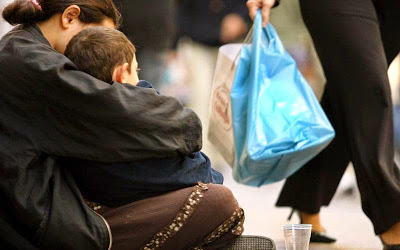Specifically, the percentage of the population facing the risk of poverty amounted to 27,8%, which is equivalent to 240.000 people in 2013, compared to 27,1% and 234.000 people in 2012. This development further distances our country from the national risk reduction target at 19,3%.
Looking back, we see the dramatic change that marks the deterioration of the poverty rate. In 2010 the percentage of the population that was faced with the poverty spectrum was 24,6% and was equivalent to 202.000 people, remaining at the same percentage and in 2011 with 207.000 people being vulnerable to poverty.
The evolution of the poverty index and other, equally important social indicators, is reflected in the National Reform Program, developed by the Presidency-Administrative Reform Unit and submitted by the Deputy Minister under the President, Konstantinos Petridis, at the end of April in Komis. The program reflects the progress in achieving the national quantitative targets set in the framework of the "Europe 2020" strategy.
As the risk of poverty spreads to a larger part of the population, at the same time the per capita expenditure on social protection in Cyprus is shrinking.
In 2012, the expenditure amounted to € 4.731, compared to € 4.783 in 2011, according to the Social Protection Survey conducted by the Statistical Service. An amount much lower than the average for the 27 Member States of the European Union, amounting to € 7.604.
As can be seen, the differences between Member States are still huge in terms of social protection. A model in support of vulnerable groups, with the highest per capita expenditure on social protection, is Luxembourg, which held the first place with € 18.862 per year, while in Bulgaria it is € 952 and is in the last place (Statistical Service).
In particular, the note on the National Reform Program, submitted to the Council of Ministers, includes the course of the employment index.
Despite the economic crisis, the employment rate increased slightly in 2014, reaching 67,6% from 67,2% in 2013. Despite the improvement, there is a significant deviation from the national target set at 75-77%, as a result of sluggish growth.
Regarding the educational level of Cypriots, the percentage of people aged 30-34 who have completed higher education increased in 2014 to 51,1% from 47,8% in 2013 and still exceeds the target of 46%.
This development can take two readings. On the one hand, it is positive that the educational level of young people is improving, but with unemployment at a high 16%, the problem is not with the quality of the workforce, but with the small number of jobs produced by the Cypriot economy.
Unsurprisingly, the positives record the reduction of the problem of dropping out of school. The percentage of students who drop out of school early decreased further to 7,9% in 2014 from 9,1% in 2013, thus meeting the target of 10%.
The percentage of Cyprus' GDP invested in research and development, which increased according to preliminary estimates in 2013 to 0,48%, compared to 0,43% in 2012, also approaching the target of 0,5, is also improving. 7,45%. Also in terms of development and use of renewable energy sources, our country exceeded the intermediate target of 2015% for the period 2016-2013, given that the share of RES in gross final energy consumption in 8,7 amounted to 7,7, 2012% (from XNUMX% in XNUMX).
According to the note, the increase in energy efficiency in projected primary consumption in 2013 reached 7%, higher than the 1,6% target for 2013.
"Shaving" social benefits and poverty
The increase in the risk of poverty in times of crisis is partly due to the contraction of state social policy, which translates into a reduction in benefits.
The Financial Report of the General Accounting Office for 2014 shows the reduction of benefits as follows:
● public aid: in 2014 expenditure amounted to € 173 million compared to € 168 million in 2013
Τέ child allowance: at € 119 million while in 2013 it was € 123 million.
● sponsorship to low-income retirees: at € 75 million while in 2013 it was € 79 million.
● social pension: € 67 million was spent compared to € 66 million in 2013
● Student sponsorship: € 49 million spent compared to € 57 million in 2013
Emphasis on innovation for long-term growth
In his speech, Marios Christou, economist, professor at the University of Nicosia, commenting on the course of the main social indicators in line with the forecasts of the European Commission, for the economic recovery, which is postponed for 2016, after suggesting that "if we read behind "Explains important findings about its prospects," he said. "Keeping employment low, far below the target in line with the growing number of people at risk of poverty, proves the structural weaknesses of the economy." for job creation and workforce absorption ".
The data, said Mr. Christou, record an increase in the number of people who have completed higher education, with the percentage being higher than the target, there is an increase in the scientific workforce and a decrease in the unskilled or low-skilled and at the same time for the creation of corresponding positions in the fields of specialization and scientific training ".
With these data, the university added, "it is a great mistake to insist that the economy base its recovery on" traditional "sectors, such as construction, where the largest percentage of the workforce is low-skilled."
He concluded that "long-term recovery requires structural change, with a shift to innovative companies, and this need is evident from research and development spending, which remains well below the EU target".
Source: FILELEFTHEROS

